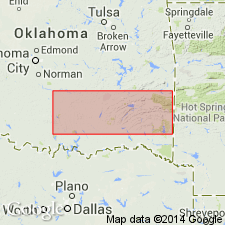
- Usage in publication:
-
- Wesley shale
- Modifications:
-
- Named
- Dominant lithology:
-
- Shale
- Chert
- AAPG geologic province:
-
- Ouachita folded belt
Summary:
Named as uppermost formation (of 4) of Jackfork group (raised in rank) of Pushmataha series (new) of the Bendian period; named for the village of Wesley. Type locality designated southwest of Wesley in the E1/2 SE1/4 NW1/4 sec 20, T1N, R13E, Atoka Co, OK, Ouachita tectonic belt province; 500 ft thick at type locality. Is one of best developed and most widespread of diagnostic shales (gray to black splintery) in Bendian stratigraphic column; found at many localities in Ouachita Mountain area. Because of the many intercalations of lenses of chert conglomerate with a siliceous bond and with the siliceous shale, this formation can easily be confused with Chickasaw Creek siliceous shale. Most of conglomerates are distinct and seem to be limestone conglomerates which have changed to chert; also contain many included shale and siliceous shale pebbles. Has large rounded to subrounded chalcedonic masses intermixed with shale. Overlies Markham Mill formation (new) of Jackfork group of Pushmataha series of Bendian period; unconformably underlies Union Valley sandstone of the Morrow series of the Bendian period. Wesley is a correlative of most of shale previously called "Pennsylvanian Caney." Contains Foraminifera (listed) and ammonites. Correlation chart. Map showing type locality. Carboniferous age.
Source: GNU records (USGS DDS-6; Denver GNULEX).
For more information, please contact Nancy Stamm, Geologic Names Committee Secretary.
Asterisk (*) indicates published by U.S. Geological Survey authors.
"No current usage" (†) implies that a name has been abandoned or has fallen into disuse. Former usage and, if known, replacement name given in parentheses ( ).
Slash (/) indicates name conflicts with nomenclatural guidelines (CSN, 1933; ACSN, 1961, 1970; NACSN, 1983, 2005, 2021). May be explained within brackets ([ ]).

